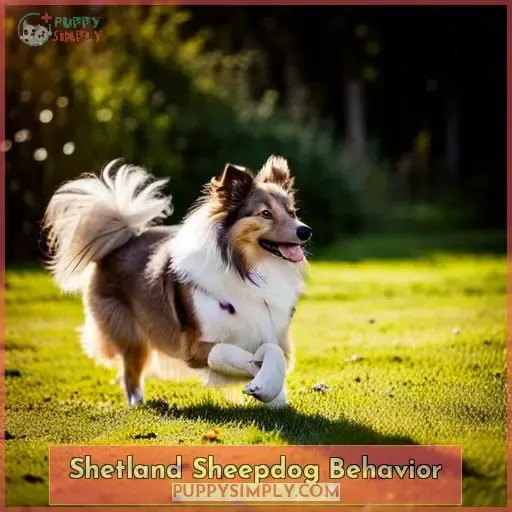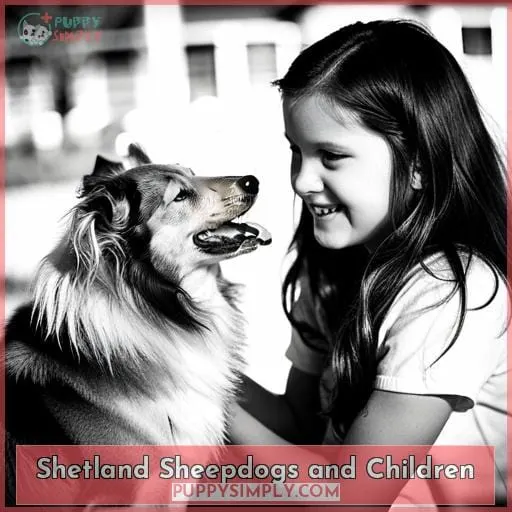This site is supported by our readers. We may earn a commission, at no cost to you, if you purchase through links.
 Delve into the realm of Shetland Sheepdogs’ behavior, unveiling the truth behind their reputation for hyperactivity.
Delve into the realm of Shetland Sheepdogs’ behavior, unveiling the truth behind their reputation for hyperactivity.
Discover the factors that influence their energy levels, from temperament and genetics to environmental stimuli.
Explore the delicate balance between physical and mental stimulation, uncovering the secrets to a harmonious and fulfilling life with your Shetland Sheepdog.
Table Of Contents
- Key Takeaways
- Shetland Sheepdog Temperament
- Shetland Sheepdog Behavior
- Shetland Sheepdog Hyperactivity
- Shetland Sheepdog Boredom
- Behavioral Problems in Shetland Sheepdogs
- Training a Shetland Sheepdog
- Shetland Sheepdogs and Family
- Shetland Sheepdogs and Children
- Shetland Sheepdogs and Other Pets
- Frequently Asked Questions (FAQs)
- Are Shetland Sheepdogs prone to anxiety when separated from their owners?
- How can I prevent my Shetland Sheepdog from nipping at children and other pets?
- What are some common health problems that Shetland Sheepdogs face?
- Are Shetland Sheepdogs suitable for families living in apartments or small spaces?
- What are some tips for grooming a Shetland Sheepdog’s coat to prevent matting and tangles?
- Conclusion
Key Takeaways
- Shetland Sheepdogs can be hyperactive and require regular exercise and mental stimulation to prevent boredom and destructive behaviors.
- Early socialization is essential to help Shetland Sheepdogs overcome their reserved nature and potential anxiety around strangers.
- Behavioral training is important for Shetland Sheepdogs to address hyperactivity, shyness, or herding behaviors.
- Canine enrichment, managing anxiety, exercise solutions, socialization techniques, and mental stimulation are key to addressing behavioral problems in Shetland Sheepdogs.
Shetland Sheepdog Temperament
You’ll find Shetland Sheepdogs with reserved personalities, making them appear shy and aloof.
This characteristic can be both endearing and challenging, as it requires patient socialization and training to bring out their true, affectionate nature.
Their natural suspicion of strangers can lead to excessive barking, a common concern among sheltie owners.
On the other hand, Shetland Sheepdogs possess remarkable adaptability, seamlessly adjusting to various living situations, whether it’s a bustling city apartment or a sprawling countryside home.
Their intelligence and eagerness to please make them highly trainable, allowing you to effectively manage their anxiety and instill good manners.
To ensure a well-balanced and content sheltie, prioritize daily exercise routines that engage their active minds and bodies.
Engage them in interactive games, provide puzzle toys, and establish a consistent schedule for walks or playtime in secure, open areas.
Mental stimulation is just as crucial, so incorporate training sessions, obedience classes, or agility exercises to keep their sharp minds occupied and prevent boredom.
Shetland Sheepdog Behavior
Let’s explore the behavior of Shetland Sheepdogs, a breed known for its reserved personality and potential shyness. Understanding their natural instincts and behaviors can help you provide the best care and training for your furry friend.
Exercise Needs:
Shetland Sheepdogs are active and energetic, requiring daily exercise to stay happy and healthy. Engage them in brisk walks, jogging, or interactive games like fetch to fulfill their exercise needs.
Socialization Tips:
Shetland Sheepdogs may be reserved with strangers, so early socialization is crucial. Expose them to various people, animals, and environments to help them become more comfortable and confident in different situations.
Anxiety Management:
Shetland Sheepdogs can be prone to anxiety, especially when left alone for extended periods. Provide them with a safe and comfortable space, such as a crate or a designated area in your home, to help them feel secure.
Mental Stimulation:
Shetland Sheepdogs are intelligent and thrive on mental challenges. Engage them in interactive toys, puzzle feeders, or obedience training to keep their minds active and prevent boredom.
Behavioral training is essential for Shetland Sheepdogs, as they can exhibit hyperactivity, shyness, or herding behaviors. Positive reinforcement and obedience training can help correct these behaviors and promote good manners.
With patience, consistency, and the right approach, you can help your Shetland Sheepdog become a well-behaved and loving companion.
Shetland Sheepdog Hyperactivity
Your Shetland Sheepdog’s intelligence and hard work ethic mean they need to be kept busy to avoid boredom and hyperactivity.
Exercise and mental stimulation are crucial for their well-being.
Regular walks, runs, or engaging games of fetch can help channel their energy positively.
Interactive toys and puzzle feeders challenge their minds, preventing boredom and destructive behaviors.
Recognize your Shetland Sheepdog’s energy levels and adjust activities accordingly.
Puppies and younger dogs typically have higher energy levels and require more exercise than older dogs.
If their exercise needs aren’t met, they may become hyperactive, restless, and engage in destructive behaviors like chewing or barking excessively.
Consistency is key in managing your Shetland Sheepdog’s energy.
Establish a routine that includes regular exercise, playtime, and mental stimulation.
This routine provides structure and predictability, helping your dog understand what’s expected of them and reducing hyperactivity.
Shetland Sheepdog Boredom
With insufficient mental and physical stimulation, your Shetland Sheepdog will become bored and restless.
Boredom often manifests as hyperactivity, destructive chewing, excessive barking, and other undesirable behaviors.
To prevent boredom, provide your Shetland Sheepdog with ample mental stimulation and physical activity.
Engage your dog in interactive play sessions, such as fetch, tug-of-war, and hide-and-seek.
Enroll your dog in obedience classes or agility training to challenge their minds and bodies.
Additionally, provide your dog with a variety of toys to keep them entertained when you’re away.
Environmental enrichment is also essential for preventing boredom.
Create a stimulating environment for your dog by rotating toys, providing interactive feeders, and hiding treats around the house.
Take your dog on regular walks or runs to explore new sights and smells.
By providing your Shetland Sheepdog with adequate mental and physical stimulation, you can help prevent boredom and its associated behavioral problems.
Behavioral Problems in Shetland Sheepdogs
- Behavioral problems in Shetland Sheepdogs can be modified or eliminated with time and effort. Canine enrichment, managing anxiety, exercise solutions, socialization techniques, and mental stimulation play crucial roles in addressing these issues.
-
Canine Enrichment:
- Provide interactive toys, puzzle feeders, and snuffle mats to stimulate their minds and prevent boredom.
-
Managing Anxiety:
- Identify triggers, create a safe space, and consider medication if necessary.
- Counter-conditioning and desensitization techniques can help reduce anxiety.
-
Exercise Solutions:
- Engage in daily physical activities like brisk walks, jogging, or fetch.
- Enroll your Shetland Sheepdog in agility or herding classes to channel their energy positively.
-
Socialization Techniques:
- Introduce your Shetland Sheepdog to various people, animals, and environments from an early age.
- Positive reinforcement and treats can help create positive associations.
-
Mental Stimulation:
- Engage your Shetland Sheepdog in training sessions, interactive games, or teach them new tricks.
- Puzzle toys and interactive feeders can also provide mental stimulation.
Training a Shetland Sheepdog
In light of possible behavioral problems, obedience classes can help your Shetland Sheepdog learn socialization and basic commands.
These classes provide a structured environment for your dog to learn and practice good behavior, while also giving you the tools you need to train your dog at home.
Training a Shetland Sheepdog requires patience, consistency, and positive reinforcement.
Start training early, using treats, praise, and play to reward good behavior.
Focus on basic obedience commands like sit, stay, come, and heel.
Once your dog has mastered these commands, you can move on to more advanced training, such as agility or tracking.
Mental engagement and exercise are essential for a Shetland Sheepdog’s well-being.
Provide your dog with plenty of opportunities to play and explore, both indoors and outdoors.
Interactive toys, puzzle feeders, and daily walks or runs are all great ways to keep your dog’s mind and body active.
Harness Their Intelligence:
Engage your Shetland Sheepdog’s sharp mind with interactive games, puzzle toys, and challenging training exercises.
Craft a Structured Routine:
Establish a consistent daily routine that includes regular mealtimes, exercise, and training sessions. This structure provides a sense of security and predictability for your dog.
Foster Socialization:
Expose your Shetland Sheepdog to various people, animals, and environments. Socialization helps them become well-rounded and comfortable in different situations.
Shetland Sheepdogs and Family
Now that you’ve laid the groundwork for training your Shetland Sheepdog, let’s delve into their family dynamics.
Shetland Sheepdogs thrive in family environments, forming deep bonds with their human companions. Their loyalty and affectionate nature make them excellent additions to households with children and other pets.
To foster a harmonious family life with your Shetland Sheepdog, socialization techniques are paramount. Introduce them to various people, animals, and environments from an early age. This exposure helps them adapt to different situations and reduces anxiety-driven behaviors.
Exercise routines are crucial for Shetland Sheepdogs’ physical and mental well-being. Regular walks, playtime in the park, or engaging in canine sports like agility or herding fulfill their exercise needs and prevent boredom, a common trigger for hyperactivity.
Managing anxiety is another key aspect of caring for a Shetland Sheepdog. They’re prone to separation anxiety, so it’s essential to gradually accustom them to being alone. Start with short absences and gradually increase the duration as they become more comfortable.
Providing them with interactive toys or calming aids can also help manage their anxiety.
Bonding activities strengthen the connection between you and your Shetland Sheepdog. Engage in activities they enjoy, such as playing fetch, going for walks, or cuddling on the couch.
Understanding behavioral cues is vital for effective communication with your Shetland Sheepdog. Learn to recognize signs of stress, anxiety, or discomfort. By being attuned to their body language and vocalizations, you can address their needs promptly and prevent the escalation of problematic behaviors.
Shetland Sheepdogs and Children
Your Shetland Sheepdog and your children can form a strong friendship with proper supervision and training.
Shetland Sheepdogs are intelligent and eager to learn, making them easy to train. They’re also loyal and loving companions who’ll make a great addition to any family.
Shetland Sheepdogs are typically good with children, but it’s important to supervise interactions, especially with young children. Teach your children how to properly interact with the dog, such as avoiding pulling its ears or tail.
You should also teach your dog basic obedience commands, such as sit, stay, and come.
Socialization is also important for Shetland Sheepdogs. Expose your dog to different people, places, and animals from a young age.
Provide your Shetland Sheepdog with plenty of playtime and interaction. They’re active dogs that need a lot of exercise. Play fetch, go for walks, or take them to the dog park. Shetland Sheepdogs are also intelligent dogs that enjoy learning new things.
With proper supervision, training, and socialization, your Shetland Sheepdog and your children can be the best of friends.
Shetland Sheepdogs and Other Pets
Because of their herding instincts, Shetland Sheepdogs may attempt to herd other pets in your home.
Introduce your Sheltie to other pets gradually and under controlled circumstances.
Shelties and Birds:
Shetland Sheepdogs may view small birds as prey, so it’s crucial to keep them separated. If you have birds, ensure your Sheltie is well-trained and never leave them unsupervised together.
Shelties and Cats:
With proper socialization, Shetland Sheepdogs and cats can coexist peacefully. Introduce them slowly and provide separate spaces for each pet.
Shelties and Rabbits:
Similar to birds, rabbits may trigger a Sheltie’s herding or chasing instincts. Keep them separated and supervise interactions closely.
Shelties and Dogs:
Shetland Sheepdogs generally get along well with other dogs, especially if socialized early. Introduce them gradually and monitor their interactions to ensure compatibility.
Shelties and Reptiles:
Due to their different needs and behaviors, Shetland Sheepdogs and reptiles aren’t typically suitable companions.
Frequently Asked Questions (FAQs)
Are Shetland Sheepdogs prone to anxiety when separated from their owners?
Shetland Sheepdogs, characterized by their reserved personalities, often experience separation anxiety when isolated from their owners.
This distress can manifest as:
- Destructive behaviors
- Incessant barking
- Neurotic tendencies
How can I prevent my Shetland Sheepdog from nipping at children and other pets?
To discourage nipping behaviors, consistently teach your Shetland Sheepdog bite inhibition and socialization skills.
Enroll your dog in obedience classes.
Provide positive reinforcement for appropriate interactions with children and pets.
What are some common health problems that Shetland Sheepdogs face?
Shetland Sheepdogs are prone to various health issues:
- Epilepsy
- Bleeding disorders
- Heart disease
- Joint disorders
- Eye diseases
- Endocrine system disorders
- Skin problems
Regular checkups are crucial for early detection and management.
Are Shetland Sheepdogs suitable for families living in apartments or small spaces?
Shetland Sheepdogs’ exercise needs can be met in small spaces with frequent, shorter walks.
Indoor activities like fetch and puzzle toys can also fulfill their exercise requirements.
Consider their emotional needs, as they thrive on companionship.
They may experience separation anxiety if left alone excessively.
What are some tips for grooming a Shetland Sheepdog’s coat to prevent matting and tangles?
Regular brushing and combing are essential for preventing matting and tangles in your Shetland Sheepdog’s coat.
Use a slicker brush and a metal comb to remove loose hair and dirt.
Pay special attention to areas prone to tangles, such as:
- Behind the ears
- Under the legs
- Around the tail
Conclusion
Ironically, hyper is an understatement for Shetland Sheepdogs.
Their boundless energy and unyielding enthusiasm can be both captivating and overwhelming.
However, with the right balance of physical and mental stimulation, you can channel their boundless energy into positive and fulfilling activities, ensuring a harmonious coexistence between you and your furry companion.















